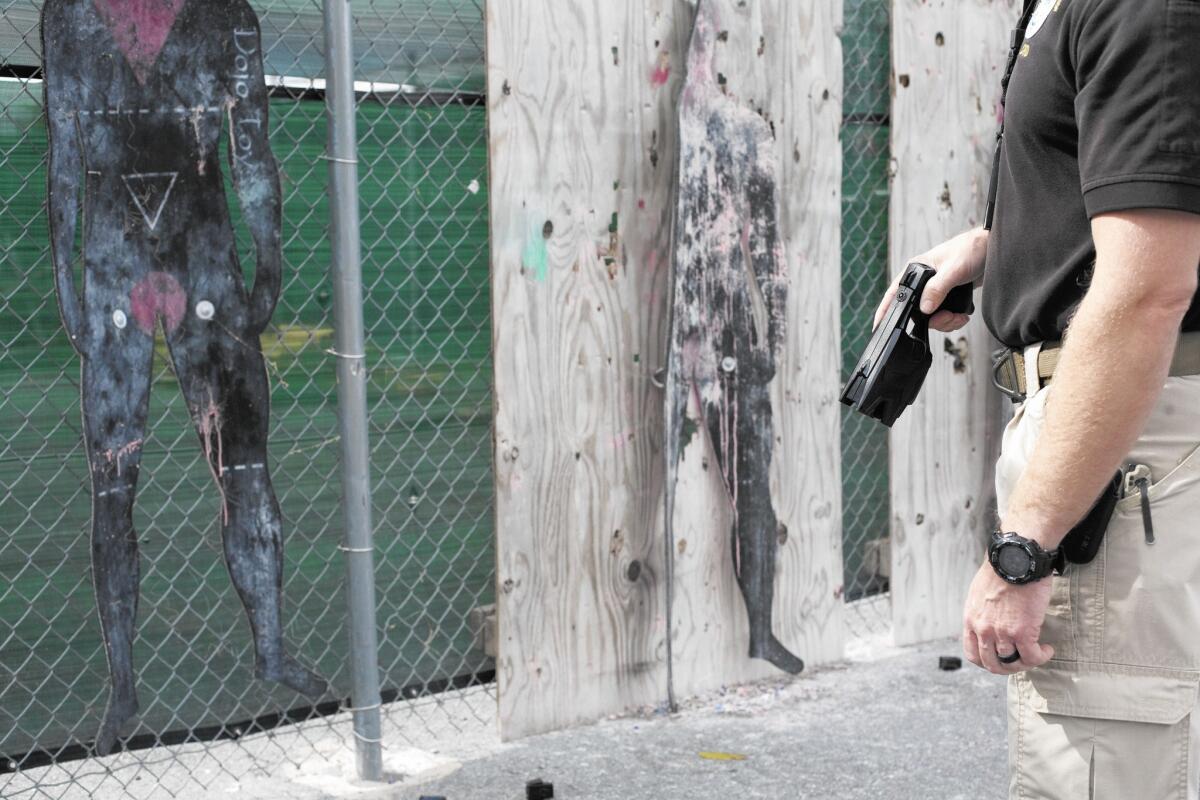Special Report: How Tasers became instruments of excessive force for the Border Patrol

A trainer at U.S. Customs and Border Protection’s Advanced Training Center in Harpers Ferry, W.Va., fires at a target using a Taser.
WASHINGTON — Searching for a way to curb fatal border shootings, Border Patrol leaders decided in 2008 that their agents needed a new weapon on their belts.
The agency began to supply Tasers, a hand-held device that delivers a paralyzing electric charge, as a way to end confrontations quickly and safely.
But in scores of cases along the border, the Tasers became instruments of excessive force, a Los Angeles Times analysis found.
The Times examined 450 uses of Tasers from 2010 to 2013 that were documented by U.S. Customs and Border Protection agents.
At least 70 times, agents fired the devices at people who were running away, even though there was no struggle or clear indication that agents were in danger, according to use-of-force reports. At least six times, agents used the weapons against people who were trying to climb over the border fence back into Mexico.
Two people were shocked while they were handcuffed. Two were hit with five cycles of the weapon, even though the agency’s policy says no one should receive more than three.
Three people died after being hit by Tasers wielded by border agents or customs officers. In one episode, 24-year-old Alex Martin, who had led agents on a car chase, burned to death after a border agent smashed his car window and fired a Taser inside. The device ignited an explosion and fireball.
Others were seriously hurt. Jose Gutierrez Guzman, a 45-year-old Mexico native who grew up in Los Angeles, was struck with a Taser in 2011 as he sprinted away from officers at an Arizona border station. He fell on his head and suffered permanent brain damage, according to a pending lawsuit he filed against the federal government.
Investigations found no wrongdoing in either case.
The Times’ analysis found that most of the people subjected to Tasers had been caught crossing the U.S.-Mexico border or were suspected of being in the country illegally, not fleeing arrest on more serious charges.
“When you put that weapon out there and they have access to it, they’re going to use it,” said Ralph Basham, the former Customs and Border Protection commissioner who authorized the use of Tasers seven years ago. “Having spent my life in law enforcement, I know you hate to see someone getting away.”
::
Questions about fatal encounters with suspects have bedeviled Customs and Border Protection, the nation’s largest law enforcement agency, mirroring the national debate over police use of force.
Since 2010, CBP personnel have killed 24 people with firearms, according to the Southern Border Communities Coalition, which tracks such cases. At least 10 were killed by agents who said they were defending themselves against rock throwing. One agent has been charged with murder. No agents have faced disciplinary action in connection with any of the deaths.
Disturbed by the number of fatalities, officials at CBP, the Border Patrol’s parent agency, turned to Tasers. They started with a pilot project in west Texas, and the devices were distributed widely to agents beginning in 2010.
Taser use escalated rapidly, CBP statistics show, from 174 incidents in 2010 to 303 in 2013. The numbers dropped in 2014, after a police organization issued a report criticizing the agency’s use of force. All told, 86 people have been injured in Taser incidents since 2010 — 68 seriously enough to require medical treatment.
The Taser, invented by a Southern California aerospace scientist, fires two prongs at a subject; if they make contact, the charge paralyzes muscles and creates incapacitating pain.
Amnesty International has linked Tasers to 540 deaths in the U.S. from 2001 to 2013, though other studies, including one by the Department of Justice in 2011, have found that serious injuries occurred in less than 1% of cases. The Justice Department study also found no clear evidence that the devices cause heart attacks.
Injuries during arrests tend to go down when a law enforcement agency begins using Tasers, according to a study by Bruce Taylor, an expert on policing practices at NORC (originally the National Opinion Research Center), a research organization at the University of Chicago.
Batons or chokeholds are far more likely than Tasers to injure a combative subject, Taylor said.
“It’s not risk-free,” said Steve Tuttle, a spokesman for Taser International, the Scottsdale, Ariz.-based maker of the devices. “But you have to look at this relative to other uses. We’re not throwing cotton balls at someone; we’re putting them down on the ground.”
::
The use-of-force reports reviewed by The Times open a window onto an unpredictable and grueling job, where agents operating in remote areas are outnumbered by border crossers, and violence is routine. In many cases, the reports show, the Tasers allowed agents to subdue suspects without injuries.
“It’s not uncommon for an agent to encounter a group of 40 people out there, and have to control the situation all by themselves,” said Chris Cabrera, a spokesman for the National Border Patrol Council, the union representing agents. “The more nonlethal options you have, the better.”
In the struggle to capture fleeing migrants on the border, the reports show, Taser use quickly became commonplace.
In May 2013, a Border Patrol agent stopped two men on the street in Brownsville, Texas, and asked where they were from. They took off running. The agent chased them and fired his Taser into one man’s back.
“The subject subsequently fell down, hitting his head on the pavement of the parking lot,” the agent’s report said.
The man, who was not identified, ended up in an intensive care unit, the report said. It offered no further information about his condition.
A month later, as agents in Brushy Canyon, southeast of Sonoita, Ariz., tracked a group suspected of entering the country illegally, one person ran. An agent fired his Taser at the man from behind. The man fell and “sustained a large scrape on his chin,” the report said.
Basham, the former commissioner, said in an interview that he was unaware that agents had been using Tasers on fleeing subjects.
“I’m not condoning shooting anyone in the back with a Taser,” he said. “If you’re in a highly tense situation, it’s always better than pulling a [gun,] but it’s no excuse.”
In a 2013 report, the nonprofit Police Executive Research Forum faulted the agency for inadequate training, weak internal investigations and giving agents too much latitude to use deadly force and Tasers. “Fleeing should not be the sole justification” for using a Taser, it said.
About the same time, agency officials reviewing the internal reports concluded that agents were misusing the weapons, said Brandon Judd, president of the agents’ union. “They’re saying, ‘OK, why did the agents use the Taser to try to apprehend somebody, instead of in an actual conflict situation?’”
R. Gil Kerlikowske, the Customs and Border Protection commissioner, issued a new use-of-force policy last year. Now, agents are instructed to use Tasers only when a suspect poses an imminent threat and to be particularly cautious when subjects are running.
Though Kerlikowske still believes “the good far outweighs the bad” with Tasers, the Border Patrol and other law enforcement agencies have become more restrained in using them, he said.
“You’re seeing much less of the Taser being used when someone is in a precarious position, or fleeing,” said Kerlikowske, a former police chief in Seattle. “I think we’ve learned a lot, and so has law enforcement.”
::
One of the agency’s most controversial use-of-force deaths involved a Taser. Anastacio Hernandez Rojas, a 42-year-old Mexican who had long lived in San Diego, was caught crossing the border illegally in 2010. He was being taken back to Mexico when, according to agents, he became combative, kicking and punching them at the Chula Vista border station.
Later, cellphone videos surfaced, showing him on the ground in handcuffs, surrounded by a dozen agents and customs officers. In one video, he could be heard screaming for help.
Evidence that surfaced in a lawsuit, including the video, an autopsy report and statements from witnesses and agents, indicated that he was hit with a baton and shocked twice with a Taser. He suffered five broken ribs and a heart attack and died three days later.
The coroner ruled the case a homicide but said it wasn’t clear what role the Taser played, adding that Rojas had an enlarged heart and methamphetamine in his system.
A federal grand jury began investigating; more than five years after Rojas died, no charges have been filed and the case remains open.
Another man, 40-year-old Francisco Cesena of El Cajon, died after repeated shocks with a Taser last Christmas Eve at the San Ysidro border station, according to an autopsy report by the San Diego medical examiner’s office.
Cesena had been detained on a felony warrant. A video captured him hurdling a gate at the border station and attacking agents, the coroner’s report said. Tasers were used “multiple times” during the eight-minute struggle, the report said, before Cesena was left gagged and handcuffed on the floor.
According to the report, he had broken ribs and at least seven pairs of apparent Taser marks on his back. Agency policy prohibits shocking someone more than three times. The report said Cesena died of a heart attack and classified the case as a homicide, brought on by the use of a Taser and his being restrained in a facedown position. Methamphetamine and heroin in his system were contributing factors, the report said.
The FBI and San Diego police are investigating.
The agency rarely finds fault with agents’ use of Tasers. From 2010 through 2014, two agents were disciplined each year for using the devices improperly — 10 in all. The agency gave no information about those cases.
::
Alex Martin caught the attention of Border Patrol agents early on March 15, 2012. An agent in an unmarked car, part of a unit trying to catch border smugglers, spotted Martin driving the wrong way on Interstate 8 in San Diego County and began following him. Martin behaved erratically, agents said, stopping on the highway, then racing off.
Martin, who lived in a Dallas suburb, had set out for California around 1 a.m. the day before in a rented Ford Focus, according to evidence in a lawsuit filed by his family. He was born in La Jolla, and he was homesick, his family said.
Martin should not have been behind the wheel. Two months earlier, he had pleaded no contest to drunk driving in Texas and was permitted to drive only his own car, which was equipped with a Breathalyzer.
Agents laid down a spike strip to slow Martin and, at a checkpoint near Pine Valley, finally forced him to the side of the road. The ensuing confrontation was captured on a dashboard camera.
Agents with guns drawn surrounded the car and shouted conflicting commands, telling Martin to both show his hands and get out of the car.
One of the agents, Roy Salcedo, later testified in a deposition that he thought Martin was reaching for the car’s center console, and he feared Martin might have a weapon. Salcedo smashed the passenger side window with a flashlight and fired his Taser.
The car burst into flames. Agents moved their cars back but didn’t try to put the fire out; they said it was too late to save Martin.
“They killed the only one I have,” said his mother, Karen Martin. “I would never like to see anyone go through what I went through.”
Why the car exploded is a mystery. The gasoline tank wasn’t leaking, according to an expert hired by the family.
The family’s suit was dismissed last month by U.S. District Judge Larry A. Burns, who said the use of the Taser was reasonable, given Martin’s “extremely reckless driving” and the risk that he might flee or reach for a weapon.
“There is no evidence [the agent] had reason to believe a fire or explosion would result,” he wrote.
Martin’s family has filed an appeal. Their lawyer, Eugene Iredale, said he believes Martin was simply lost and confused.
“This is a living, breathing young man who died in a horrible, horrible way,” said Martin’s stepmother, Joellyn Martin. “Tasers are dangerous. Tasers, I think, are not the answer to not using a weapon. I’m sure there are right situations, but this isn’t one of them.”
Times staff writers Doug Smith and Sandra Poindexter contributed to this report.
More to Read
Sign up for Essential California
The most important California stories and recommendations in your inbox every morning.
You may occasionally receive promotional content from the Los Angeles Times.












